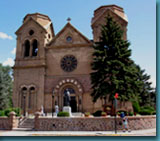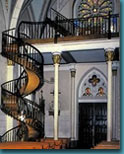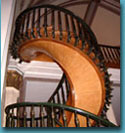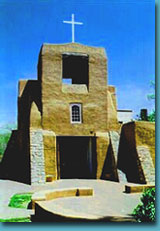Santa Fe Historic Churches
The creator of this website's family heritage dates back to before Santa Fe was recognized as a State. That combined with her world wide travel experience make this website one of the most informative that you will find. In addition to links to Santa Fe's preferred lodging, dining, theater and more, you will find special notes on this page about Santa Fe Historic Churches that make it interesting, unique and delightful. Enjoy!
From A BRIEF
HISTORY of the Archdiocese of Santa Fe, New Mexico "By 1853, the Vicariate Apostolic had become a See in its own right, the Diocese of Santa Fe, and on February 12, 1875, the Diocese of Santa Fe was elevated to an Archdiocese with Bishop Lamy as its first Archbishop. "In 1869 Bishop Lamy began building a stone cathedral, to replace the old adobe church, parts of which had served the parishioners of Santa Fe since 1717 (the Conquistadora Chapel is all that remains). The new stone Cathedral was built around and over the old church, in the style of the Romanesque churches of France familiar to Bishop Lamy. By 1884 the main part of the Cathedral was finished and the old church was torn down from under it. Archbishop Lamy died on February 14, 1888 and is buried under the sanctuary floor of his beloved St. Francis Cathedral. He was succeeded as Archbishop of Santa Fe by John Baptist Salpointe. Archbishop John Baptist Pitaval, fifth Archbishop of Santa Fe, dedicated the bronze statue of Archbishop Lamy which stands in front of the Cathedral on May 23, 1915."
SPECIAL
NOTE: |
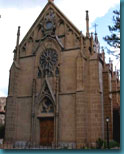 |
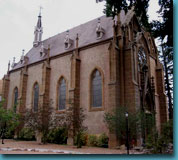 |
LORETTO
CHAPEL
Home of the Miraculous Staircase |
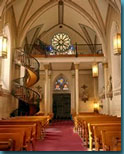 |
||||
|
At
the end of the Old Santa Fe Trail stands the Loretto Chapel. The history
of the small Chapel began when Bishop Jean Baptisite Lamy was appointed
by the Church to the New Mexico Territory in1850. Bishop Lamy, seeking
to spread the faith and bring an educational system to this new territory,
began a letter writing plea for priests, brothers and nuns to preach
and teach. In one of his letters he is said to have written, “I
have 6000 Catholics and 300 Americans.” The first acceptance
of his general plea was from the Sisters of Loretto.
In 1852 the Sisters of Loretto responded to Lamy’s pleas by sending seven sisters who agreed to make this arduous journey to Santa Fe. Their trek was through St. Louis, then up the river to Independence, Mo. This small group was beset by a cholera epidemic, the Mother Superior died, and another nun was too ill to continue the journey and returned to Kentucky. The remaining nuns traveled by wagon through bad weather, and Indian country. They arrived in Santa Fe in 1852 and opened the Academy of Our Lady of Light (Loretto) in1853. The campus covered a square block with 10 buildings. The school was started and grew from very small beginnings to a school of around 300 students, despite the challenges of the territory (smallpox, tuberculosis, leaky mud roofs and even a brush with the rowdy Confederate Texans during the Civil War). Through tuition’s for the girls schooling, donations, and from the sisters own inheritances from their families, they built their school and chapel. The Loretto Academy was closed in 1968, and the property was put up for sale. At the time of sale in 1971, Our Lady of Light Chapel was informally deconsecrated as a Catholic Chapel. PERSONAL NOTE: My mother was a boarding student as a young girl at Loretto Academy (now the Inn at Loretto). She was often encouraged by other Loretto Academy boarding students to sneak out to buy candy at the nearby drug store on the Plaza.. Being of small physic she could easily get through spaces in the wall but more often than not she was caught by the nuns upon her return, arms and pockets loaded with goodies, and as punishment she had to polish the famous Loretto Chapel's Miraculous Spiral Staircase by hand with cotton balls! During the first period of construction of the St. Francis Cathedral, and as an apparent afterthought, Archbishop Lamy advised and encouraged the sisters to utilize architect Antoine Mouly and his son, Projectus Mouly (whom he brought from Paris to design the St. Francis Cathedral), to design and build their dream chapel. The older Mouly had been involved in the renovation of San Chapel, in Paris, in the early 1800’s. Mouly was encouraged to fashion the Loretto Chapel after the San Chapel. It was the favorite chapel of the archbishop from his early days in Paris, France. It is reported that the sisters pooled their own inheritances to raise the $30,000 required to build this beautiful Gothic chapel. Property was purchased and in 1873 work began on the Loretto Chapel. Undoubtedly influenced by the French clergy in Santa Fe, the Gothic Revival-style chapel was patterned after King Louis IX's Sainte-Chapelle in Paris; a striking contrast to the adobe churches already in the area. Stone for the Chapel was quarried from locations around Santa Fe including Cerro Colorado, about 20 miles from Santa Fe near the town of Lamy. The sandstone for the walls and the porous volcanic stone used for the ceiling were hauled to town by wagon. The ornate stained glass in the Loretto Chapel also made part of its journey to Santa Fe via wagon. Purchased in 1876 from the DuBois Studio in Paris, the glass was first sent from Paris to New Orleans by sailing ship and then by paddle boat to St. Louis, MO. where it was taken by covered wagon over the Old Santa Fe Trail to the Chapel. The Chapel was completed in 1878 and has since seen many additions and renovations such as the introduction of the Stations of the Cross, the Gothic altar and the frescos during the 1890s. Loretto Chapel is now a private museum operated and maintained, in part, for the preservation of the Miraculous Staircase and the Chapel itself.
|
|||||||


